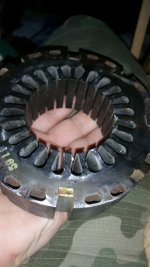jkrych said:
narrower stators = lower torque than wider ones, all else the same.
i had an option for a three inch stator that was just a bit thicker than this one that was an outrunner, but the weight and size leads me to believe this inrunner style will have a higher power potential
Note that I said "all else the same".
If they're not the same (other than width) you can't directly compare a wider to a narrower motor--just being outrunner vs inrunner makes a difference, as does the diameter change, etc.
As for "power potential", size and weight don't necessarily have anythign to do with that, given that the two motors are essentially completely different from each other.
A motor with more physical mass can take a certain peak power for longer than one with a lower mass, but if the "containment" of the heat buildup is the same between them, then their continuous power limit would be teh same, if they both have the same wasted power inside them (efficiency).
If one is easier to cool than the other, you could get mroe continuous power out of it, as long as you actualy do cool it better.
If one is more efficient than the other, same thing.
If one is spun at a higher RPM, then all else the same (which they aren't), it could provide higher power, but it would have to be enough to overcome all the losses inherent in converting that higher RPM down to the range you need. A small motor can provide the same power a big motor can if you spin the small one faster (and keep it cool).
Castle controllers are often called Castle Cremations due to the way they fry when loaded incorrectly/etc. Don't know that you'll get 11kw out of one.
the reason i asked is they are commonly used on 10 cells at excess of 200 amps in rc boats, so i figured that was right in my power range.
200A continous, or peak? And for how long?
I see over 100A battery current (different from motor current) on my SB Cruiser trike, but that's only at startup for a couple seconds, until I begin to accelerate less as I'm approaching cruising speed. After that it's less than a fifth of that worst case, and a tenth best case.
On most RC stuff, the props or wheels are essentially unloaded at startup, compared to using the same type of setup to drive a massive (hundreds of pounds) vehicle/rider. Their startup peaks are much much shorter, so the controllers (and motors) have plenty of time to cool down after that, and not much time during the peak to build up heat inside them to start with. The massive vehicle will have much longer peaks, with much more time to build up heat.
Even with external cooling setups, there may not be time enough to remove all that heat before damage occurs, especially inside the tiny RC controllers, which are not built in a way that enables easy removal of that heat--it tends to be concentrated and kept inside the parts for much longer than it would in a controller designed for higher continuous power levels, with cooling of the heat-generating parts being more direct than the typical RC stuff.
When inductance is too low on the motor, it causes even higher phase currents, which heats the controller even faster and to higher temperatures, and makes it more likely that any controller that allows heat buildup inside will fail spectacularly.
well, the most accurate torque requirement i can estimate is based off a startup peak, but id say its close to 5 newton meters.
That's pretty low torque.
Not really a direct comparison, but it takes more than that to keep my SB Cruiser trike cruising at 20MPH, with the 20" wheel on a MXUS 3T DD hubmotor. Estimate 75Nm+ startup torque with it. The 4T on the other side estimates over 100Nm at startup.
http://www.ebikes.ca/tools/simulator.html?bopen=true&motor=MX4503&batt=B5216_GA&cont=C40&wheel=20i&frame=ELF&mass=170&hp=0&axis=mph&throt=56&cont_b=C40&motor_b=MX4504&batt_b=B5216_GA&wheel_b=20i&frame_b=ELF&mass_b=170&hp_b=0&throt_b=74
my target rpm is 15000, but the motor does not need to be direct drive, so i think that can be worked out in winding and with a gearbox.
Why such a high RPM?
Note that gearboxes are going to be pretty loud with such high RPMs, assuming you can find some that will handle the power levels you're after at such RPMs.
Most of the stuff I've seen that reduces really high (RC motor level) RPMs to get more torque out of a small motor uses a belt reduction first stage, rather than gears, then a second stage taht can be another belt, or a chain, or gears.
I havent' worked with any stuff that uses a gearbox to get *higher* RPM out of a motor, so I don't know what that would be like.


